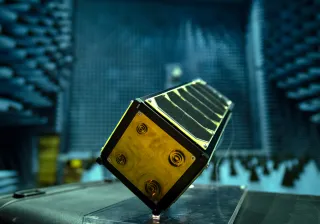The European Space Agency ESA and NASA are working together to determine how the Earth might be protected against the threat posed by asteroids by altering their trajectory. VTT is taking part in the project by determining the mineral composition of the asteroids. This is happening for the first time with a nanosatellite mounted hyperspectral camera.
The joint ESA and NASA mission will test deflecting asteroids using a kinetic impactor – a probe that is steered to collide with an asteroid. The impactor is called DART (Double Asteroid Redirection Test) and is provided by NASA. The purpose of DART is to change the trajectory of the asteroid.
Understanding the effects of a collision requires information on the asteroid’s composition and structure: this will be done by ESA’s Hera spacecraft. Piggybacking with Hera are two small nanosatellites: Milani (Italy) and Juventas (Luxembourg). The Asteroid Spectral Imager ASPECT, developed by VTT Technical Research Centre of Finland, is the main payload of the Milani satellite and a key part of the whole Hera mission.
ASPECT operates in wavelengths between 500 and 2500 nanometres and can be used to determine the mineral composition of asteroids. Similar technology is being used on Earth in several applications such as studying skin cancer, measuring gas emissions, and sorting plastic for recycling.
Launch in 2024
The Hera mission is to be launched in 2024. “This will be a significant step toward the utilisation of nanosatellites in the study of deep space objects. The performance of the miniaturized instruments starts to be adequate for determining the composition of asteroids, and this will enable cost-effective missions to study asteroids and other planetary bodies”, says Antti Näsilä, Research Team Leader at VTT.
VTT has been developing ASPECT since 2015, so finalizing the flight instrument contract is a significant milestone. The science coordinator for Milani is University of Helsinki. Other partners include Reaktor Space Lab, which will develop the data processing unit for ASPECT, and Huld, which is responsible for software development for the mission. The Milani nanosatellite is to be built by the Italian company Tyvak International.
“The small ASPECT instrument placed in Milani will produce the first high-resolution hyperspectral image of the surface of an asteroid, surveying its global and local mineral composition. Didymos is a special target, as it is a binary asteroid – an asteroid that has a smaller asteroid as a moon. No such binary targets have been studied before in situ. Data to be collected using the ASPECT instrument will also reveal significant information on the origin and development of binary asteroids and a possible exchange of matter between these two objects”, says Adjunct Professor Tomas Kohout of the University of Helsinki.
Survey creates basis for asteroid mining
Nanosatellites and the hyperspectral camera will help bring down the costs of asteroid research to a fraction of what they are now. The total costs of the Milani satellite are about EUR 7 million, of which the hyperspectral camera accounts for an estimated one million. When the design is multiplied, the total cost is expected to go down to about a million euros per satellite. This corresponds roughly to about one percent of the cost of a traditional satellite.
The solution enables comprehensive mapping of asteroids using hundreds of probes. The probes would provide key information for asteroid prospecting, which is the first step in asteroid mining. Asteroid mining could bring great opportunities to overcome the limited natural resources on Earth. For example, rare minerals required in the electronics industry could be mined from asteroids. Asteroids with the most interesting mineral content could be identified in the next 10 - 20 years and extraction might be possible in 50 years.
Further information
VTT Technical Research Centre of Finland Ltd
Research Team Leader Antti Näsilä, tel. +358 40 671 6266, [email protected]
University of Helsinki
Adjunct Professor Tomas Kohout, tel. +358 2941 51008, [email protected]








